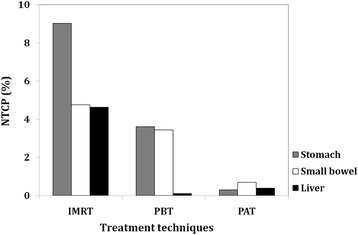A treatment planning study of proton arc therapy for para-aortic lymph node tumors: dosimetric evaluation of conventional proton therapy, proton arc therapy, and intensity modulated radiotherapy
- PMID: 27769262
- PMCID: PMC5073975
- DOI: 10.1186/s13014-016-0717-4
A treatment planning study of proton arc therapy for para-aortic lymph node tumors: dosimetric evaluation of conventional proton therapy, proton arc therapy, and intensity modulated radiotherapy
Abstract
Background: The purpose of this study is to evaluate the dosimetric benefits of a proton arc technique for treating tumors of the para-aortic lymph nodes (PALN).
Method: In nine patients, a proton arc therapy (PAT) technique was compared with intensity modulated radiation therapy (IMRT) and proton beam therapy (PBT) techniques with respect to the planning target volume (PTV) and organs at risk (OAR). PTV coverage, conformity index (CI), homogeneity index (HI) and OAR doses were compared. Organ-specific radiation induced cancer risks were estimated by applying organ equivalent dose (OED) and normal tissue complication probability (NTCP).
Results: The PAT techniques showed better PTV coverage than IMRT and PBT plans. The CI obtained with PAT was 1.19 ± 0.02, which was significantly better than that for the IMRT techniques. The HI was lowest for the PAT plan and highest for IMRT. The dose to the OARs was always below the acceptable limits and comparable for all three techniques. OED results calculated based on a plateau dose-response model showed that the risk of secondary cancers in organs was much higher when IMRT or PBT were employed than when PAT was used. NTCPs of PAT to the stomach (0.29 %), small bowel (0.69 %) and liver (0.38 %) were substantially lower than those of IMRT and PBT.
Conclusion: This study demonstrates that there is a potential role for PAT as a commercialized instrument in the future to proton therapy.
Keywords: Intensity modulated radiation therapy (IMRT); Normal tissue complication probability (NTCP); Organ equivalent doses (OED); Proton arc therapy (PAT); Proton beam therapy (RBT).
Figures




References
MeSH terms
LinkOut - more resources
Full Text Sources
Other Literature Sources

